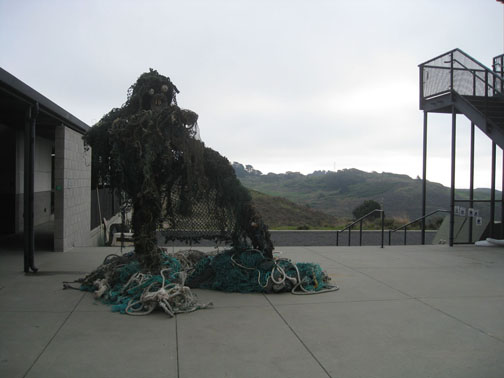Glad
tidings…from Kehoe Beach
We
are sure glad about what transpired this year. We are grateful to the many
enthusiastic supporters who helped us spread the word - our beach plastic
project has educated and entertained from Kehoe Beach to Zürich, from Monterey
to Tbilisi.
Special
thanks to the special people who helped our story go far and wide.
We started 2012 with Masterpiece Made of Trash for the Travel Channel series Bizarre Collections.
We started 2012 with Masterpiece Made of Trash for the Travel Channel series Bizarre Collections.
Mike
Leonard from CBS produced Oceans and Art that premiered on the Today show- yes,
that TODAY show first-thing-in-the-morning If you missed it live it is now available
on Vimeo.
Via
SKYPE we were live on prime time Tokyo WOWOW TV. No, we have not yet found any
tsunami plastic but we do find plastic from Japan all of the time.
The Plastic in Question
graced the 1st, 4th and 5th floors of the San
Francisco Public Library-Main Branch. The library staff was a dream of a team
to help us refigure our blog into reader friendly text panels that were perfect
for the library going public.
We were Washed Ashore, the cover story in the summer issue of National Parks magazine.
We were Washed Ashore, the cover story in the summer issue of National Parks magazine.
One Plastic Beach
is the little movie that could. To date it has had quite an Internet presence
with 143,100 hits on Vimeo. All year it’s been on the road, traveling
throughout the US with Mountainfilm in Telluride and the Wild and Scenic Film
Festival.
And
thanks to Teknion we have been on the road too. We presented Indra’s Net our power point to
workshop participants at the Dallas Museum of Art and the Newseum in Washington
D.C.
Our
Kehoe Beach nurdles or "Mermaid's Tears," as they are more poetically
named, are included in Out to Sea? that opened at the Museum für Gestaltung
Zürich (Museum of Design Zurich) and has now moved on to Museum für Kunst und Gewerbe Hamburg until March 31, 2013
"The Ghost Below" opened December 1 at The Marine Mammal Center. Our looming
nine-foot "monster" made from ghost nets and derelict fishing gear
from the stomach of a beached sperm whale is the first in a series of
exhibitions and events to highlight the problem of marine mammal entanglement.
June
1, mark your calendar
The
Oakland Museum has been under construction for a long time – when the natural
science area is completed it will be the first time in five years that all
areas of the museum will be open. Plan to visit the art, the history AND the
nature on June 1, 2013. You can see our installation The Great Conveyor in the Cordell Bank area.
March
22, mark your calendar
We
have of late turned our attention to a somber bit of plastic jetsam. Through
the years we have amassed quite a collection of toy soldiers. When we look into
their tiny faces we are amazed by their expressions. Wracked by a long life at
sea, some of the faces are gnarled, chewed on, abraded by the sand. Each is a poignant
reminder of the ravages of war. March 22 – April 28 we will present The True
Cost of Plastic
at Gallery Route One in Point Reyes Station.
Seems like Kehoe Beach is not going to be plastic-free anytime soon so until then we will be doing our best to do something about it. Our most important effort is stemming the tide. Stopping the plastic before it even gets to the beach. Re-thinking everything, every piece of plastic we use and asking ourselves- do we need this?
Seems like Kehoe Beach is not going to be plastic-free anytime soon so until then we will be doing our best to do something about it. Our most important effort is stemming the tide. Stopping the plastic before it even gets to the beach. Re-thinking everything, every piece of plastic we use and asking ourselves- do we need this?




























